|
Last Modified: 07-31-2024 |
6.11:8.1.0 |
Doc ID: RM1000000026XC3 |
|
Model Year Start: 2023 |
Model: Corolla |
Prod Date Range: [09/2022 - 11/2022] |
|
Title: THEFT DETERRENT / KEYLESS ENTRY: SMART KEY SYSTEM (for Start Function, HV Model): TERMINALS OF ECU; 2023 MY Corolla Corolla HV [09/2022 - 11/2022] |
TERMINALS OF ECU
CHECK CERTIFICATION ECU (SMART KEY ECU ASSEMBLY)
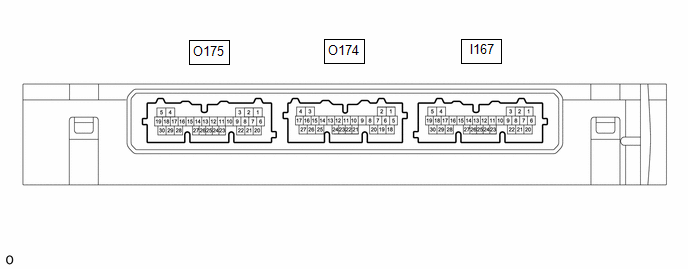
(a) Disconnect the O175 and I167 certification ECU (smart key ECU assembly) connectors.
(b) Measure the resistance and voltage according to the value(s) in the table below.
HINT:
Measure the values on the wire harness side with the connector disconnected.
|
Tester Connection
|
Terminal Description
|
Condition
|
Specified Condition
|
Related Data List Item/DTC
|
|
O175-21 (STP1) - Body ground
|
Stop light switch signal
|
Brake pedal depressed → Brake pedal released
|
9 V or higher → 1 V or less
|
|
|
I167-6 (+B) - I167-29 (E)
|
Power source
|
Ignition switch off
|
11 to 14 V
|
-
|
|
I167-14 (P) - I167-29 (E)
|
P position signal
|
Shift position in P → Shift position not in P
|
30 kΩ or higher → Below 200 Ω
|
|
|
O175-22 (CUTB) - Body ground
|
Dark current cut pin*
|
Ignition switch off
|
11 to 14 V
|
-
|
|
I167-29 (E) - Body ground
|
GND
|
Always
|
Below 1 Ω
|
-
|
|
I167-11 (SLP) - I167-29 (E)
|
GND
|
Always
|
Below 1 Ω
|
-
|
|
I167-23 (SSW3) - Body ground
|
SSW3 contact signal
|
Power switch pushed → Power switch not pushed
|
Below 15 Ω → 10 kΩ or higher
|
|
|
I167-27 (SSW2) - Body ground
|
SSW2 contact signal
|
Power switch pushed → Power switch not pushed
|
Below 15 Ω → 10 kΩ or higher
|
|
|
I167-19 (SSW1) - Body ground
|
SSW1 contact signal
|
Power switch pushed → Power switch not pushed
|
Below 15 Ω → 10 kΩ or higher
|
|
-
*: In order to prevent the vehicle auxiliary battery from being depleted when the vehicle is shipped long distances, a fuse that cuts unnecessary electrical load while the vehicle is being shipped is installed in the circuit. If the fuse is removed, the circuit becomes open. If the fuse that is between the vehicle auxiliary battery and terminal CUTB is removed and the circuit is open, the certification ECU (smart key ECU assembly) changes to a certain control mode (example: the transmission of radio waves every 0.25 seconds, which form the detection area, stops).
(c) Connect the O175 and I167 certification ECU (smart key ECU assembly) connectors.
(d) Measure the voltage and resistance, and check for pulses according to the value(s) in the table below.
|
Tester Connection
|
Terminal Description
|
Condition
|
Specified Condition
|
Related Data List Item/DTC
|
|
I167-8 (LIN) - I167-29 (E)
|
LIN communication line
|
Ignition switch ON
|
Pulse generation
|
-
|
|
I167-14 (P) - I167-29 (E)
|
P position signal
|
Shift position in P → Shift position not in P
|
9 V or higher → 2.76 V or less
|
|
|
I167-23 (SSW3) - I167-29 (E)
|
SSW3 contact signal
|
Power switch not pushed → Power switch pushed
|
9 V or higher → 1 V or less
|
|
|
I167-27 (SSW2) - I167-29 (E)
|
SSW2 contact signal
|
Power switch not pushed → Power switch pushed
|
9 V or higher → 1 V or less
|
|
|
I167-19 (SSW1) - I167-29 (E)
|
SSW1 contact signal
|
Power switch not pushed → Power switch pushed
|
9 V or higher → 1 V or less
|
|
|
I167-21 (ACCD) - I167-29 (E)
|
ACC signal
|
Ignition switch off → Ignition switch ACC
|
1 V or less → 8.5 V or higher
|
|
|
O175-11 (IGRD) - I167-29 (E)
|
IG signal
|
Ignition switch off → Ignition switch ON
|
1 V or less → 9 V or higher
|
Power Source Control
-
IGR Relay Circuit (Outside) Monitor
|
|
O175-24 (IGPD) - I167-29 (E)
|
IG signal
|
Ignition switch off → Ignition switch ON
|
1 V or less → 9 V or higher
|
Power Source Control
-
IGP Relay Circuit (Outside) Monitor
|
|
O175-13 (SPD) - I167-29 (E)
|
Vehicle speed signal
|
Vehicle being driven at approx. 5 km/h (3 mph)
|
Pulse generation
(See waveform 1)
|
Power Source Control
-
Vehicle Running Condition (Line)
|
|
O175-2 (ST2) - I167-29 (E)
|
STSW signal
|
With the brake pedal depressed, the power switch is pressed and held → After approx. 3 sec. has elapsed, the power switch is released
|
8.5 V or higher → 1 V or less
|
-
|
|
I167-4 (CLG5) - I167-29 (E)
|
Output to No. 1 indoor electrical key antenna assembly (front floor)
|
Procedure:
-
Ignition switch off
-
Electrical key transmitter sub-assembly not inside vehicle
-
Within 30 seconds of closing any door
|
Pulse generation
(See waveform 2)
|
-
|
|
I167-5 (CG5B) - I167-29 (E)
|
Output to No. 1 indoor electrical key antenna assembly (front floor) (terminal on opposite side of component from CLG5 output terminal)
|
Procedure:
-
Ignition switch off
-
Electrical key transmitter sub-assembly not inside vehicle
-
Within 30 seconds of closing any door
|
Pulse generation
(See waveform 2)
|
-
|
|
I167-30 (AGND) - Body ground
|
Transponder key amplifier ground
|
Always
|
Below 1 Ω
|
-
|
|
I167-12 (ANT1) - I167-30 (AGND)
|
Signal input / output from transponder key coil (transponder key coil built into power switch)
|
Ignition switch off, electrical key transmitter sub-assembly not in cabin, within 30 seconds of power switch pressed
|
Pulse generation
(See waveform 3)
|
|
|
I167-13 (ANT2) - I167-30 (AGND)
|
Signal input / output from transponder key coil (transponder key coil built into power switch)
|
Ignition switch off, electrical key transmitter sub-assembly not in cabin, within 30 seconds of power switch pressed
|
Pulse generation
(See waveform 3)
|
|
I167-25 (IND) - I167-29 (E)
|
Security indicator output
|
Ignition switch off → ON
|
Pulse generation → Below 2 V
|
-
|
|
O174-20 (WCSW) - I167-29 (E)*
|
Wireless charger system stop signal
|
Procedure:
-
Ignition switch off
-
Electrical key transmitter sub-assembly inside vehicle
-
Ignition switch off → ACC or ON
|
Below 1 V → 4.5 to 6 V
(For 1 second after ignition switch to ACC or ON)
|
-
|
-
*: w/ Wireless Charging System
(e) Using an oscilloscope, check the waveform of the ECU.
NOTICE:
The oscilloscope waveform shown in the illustration is an example for reference only. Noise, chattering, etc. are not shown.
(1) Waveform 1
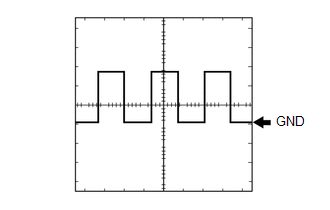
Measurement Condition
|
Item
|
Content
|
|
Tester Connection
|
O175-13 (SPD) - I167-29 (E)
|
|
Tool Setting
|
5 V/DIV., 20 ms./DIV.
|
|
Condition
|
Vehicle being driven at approx. 5 km/h (3 mph)
|
HINT:
The wavelength becomes shorter as the vehicle speed increases.
(2) Waveform 2
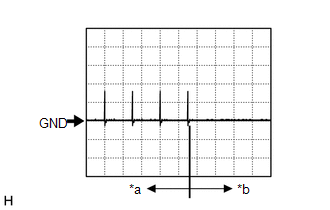
|
*a
|
For 30 seconds after any door closed
|
|
*b
|
After 30 seconds or more have elapsed since any door closed
|
Measurement Condition
|
Item
|
Content
|
|
Tester Connection
|
I167-4 (CLG5) - I167-29 (E)
I167-5 (CG5B) - I167-29 (E)
|
|
Tool Setting
|
5 V/DIV., 500 ms/DIV.
|
|
Condition
|
Procedure:
-
Ignition switch off
-
Electrical key transmitter sub-assembly not inside vehicle
-
Within 30 seconds of closing any door
|
(3) Waveform 3
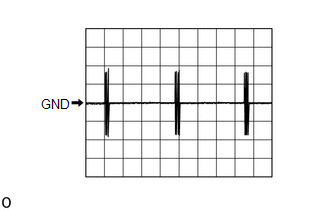
Measurement Condition
|
Item
|
Content
|
|
Tester Connection
|
I167-12 (ANT1) - I167-30 (AGND)
I167-13 (ANT2) - I167-30 (AGND)
|
|
Tool Setting
|
5 V/DIV., 200 ms/DIV.
|
|
Condition
|
Ignition switch off, electrical key transmitter sub-assembly not in cabin, within 30 seconds of power switch pressed
|
CHECK ID CODE BOX (IMMOBILISER CODE ECU)

(a) Disconnect the I20 ID code box (immobiliser code ECU) connector.
(b) Measure the voltage and resistance according to the value(s) in the table below.
HINT:
Measure the values on the wire harness side with the connector disconnected.
|
Tester Connection
|
Terminal Description
|
Condition
|
Specified Condition
|
Related Data List Item
|
|
I20-1 (+B) - Body ground
|
Power source
|
Ignition switch off
|
11 to 14 V
|
-
|
|
I20-5 (GND) - Body ground
|
Ground
|
Always
|
Below 1 Ω
|
(c) Reconnect the I20 ID code box (immobiliser code ECU) connector.
(d) Measure the voltage and check for pulses according to the value(s) in the table below.
|
Tester Connection
|
Terminal Description
|
Condition
|
Specified Condition
|
Related Data List Item
|
|
I20-3 (EFII) - I20-5 (GND)
|
EFI communication input
(Signal input from hybrid vehicle control ECU to ID code box (immobiliser code ECU))
|
Ignition switch off
|
11 to 14 V
|
Smart Key
-
EFI Code Receive
-
Start Request
|
|
I20-3 (EFII) - I20-5 (GND)
|
EFI communication input
(Signal input from hybrid vehicle control ECU to ID code box (immobiliser code ECU))
|
Within 3 seconds of hybrid control system start or within 3 seconds of ignition switch turned to ON after cable disconnected and reconnected to auxiliary battery
|
Pulse generation
(See waveform 1)
|
|
I20-4 (EFIO) - I20-5 (GND)
|
EFI communication output
(Signal output from ID code box (immobiliser code ECU) to hybrid vehicle control ECU)
|
Ignition switch off
|
Below 1 V
|
|
I20-4 (EFIO) - I20-5 (GND)
|
EFI communication output
(Signal output from ID code box (immobiliser code ECU) to hybrid vehicle control ECU)
|
Within 3 seconds of hybrid control system start or within 3 seconds of ignition switch turned to ON after cable disconnected and reconnected to auxiliary battery
|
Pulse generation
(See waveform 2)
|
|
I20-2 (LIN1) - I20-5 (GND)
|
LIN communication line
|
Ignition switch ON
|
Pulse generation
|
-
|
(e) Using an oscilloscope, check the waveform.
NOTICE:
The waveform shown in the illustration is an example for reference only. Noise, chattering, etc. are not shown.
(1) Waveform 1

|
*a
|
Approximately 160 ms.
|
*b
|
Approximately 270 ms.
|
|
Item
|
Content
|
|
Tester Connection
|
I20-3 (EFII) - I20-5 (GND)
|
|
Tool Setting
|
2 V/DIV., 500 ms./DIV.
|
|
Condition
|
Within 3 seconds of hybrid control system start or within 3 seconds of ignition switch turned to ON after cable disconnected and reconnected to auxiliary battery
|
(2) Waveform 2

|
*a
|
Approximately 160 ms.
|
*b
|
Approximately 270 ms.
|
|
Item
|
Content
|
|
Tester Connection
|
I20-4 (EFIO) - I20-5 (GND)
|
|
Tool Setting
|
2 V/DIV., 500 ms./DIV.
|
|
Condition
|
Within 3 seconds of hybrid control system start or within 3 seconds of ignition switch turned to ON after cable disconnected and reconnected to auxiliary battery
|
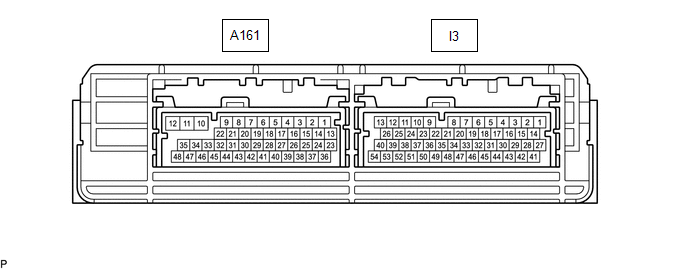
CHECK HYBRID VEHICLE CONTROL ECU
(a) Measure the voltage and resistance, and check for pulses according to the value(s) in the table below.
|
Terminal No. (Symbol)
|
Terminal Description
|
Condition
|
Specified Condition
|
Related Data List Item/DTC
|
|
I3-8 (+B1) - I3-1 (E1)I2-35 (IG2) - I3-1 (E1)
|
Ignition power supply
|
Ignition switch ON
|
11 to 14 V
|
-
|
|
I3-1 (E1) - Body ground
|
Ground
|
Always
|
Below 1 Ω
|
-
|
|
I3-39 (IMO) - I3-1 (E1)
|
EFI communication output
(Signal output from hybrid vehicle control ECU to ID code box (immobiliser code ECU))
|
Ignition switch off
|
11 to 14 V
|
-
EFI Code Receive
-
Start Request
|
|
I3-39 (IMO) - I3-1 (E1)
|
EFI communication output
(Signal output from hybrid vehicle control ECU to ID code box (immobiliser code ECU))
|
Within 3 seconds of hybrid control system start or within 3 seconds of ignition switch turned to ON after cable disconnected and reconnected to auxiliary battery
|
Pulse generation
(See waveform 1)
|
|
I3-53 (IMI) - I3-1 (E1)
|
EFI communication input
(Signal input from ID code box (immobiliser code ECU) to hybrid vehicle control ECU)
|
Ignition switch off
|
11 to 14 V → 1 V or less
|
|
I3-53 (IMI) - I3-1 (E1)
|
EFI communication input
(Signal input from ID code box (immobiliser code ECU) to hybrid vehicle control ECU)
|
Within 3 seconds of hybrid control system start or within 3 seconds of ignition switch turned to ON after cable disconnected and reconnected to auxiliary battery
|
Pulse generation
(See waveform 2)
|
|
I3-11 (ST2) - I3-1 (E1)
|
Hybrid control system start request signal
|
With the brake pedal depressed, the power switch is pressed and held → After approx. 3 sec. has elapsed, the power switch is released
|
8.5 V or higher → 1.0 V or less
|
-
|
(b) Using an oscilloscope, check the waveform.
NOTICE:
The waveform shown in the illustration is an example for reference only. Noise, chattering, etc. are not shown.
(1) Waveform 1 (Reference)

|
*a
|
Approximately 160 ms.
|
*b
|
Approximately 270 ms.
|
Measurement Condition
|
Item
|
Content
|
|
Tester Connection
|
I3-39 (IMO) - I3-1 (E1)
|
|
Tool Setting
|
2 V/DIV., 500 ms./DIV.
|
|
Condition
|
Within 3 seconds of hybrid control system start or within 3 seconds of ignition switch turned to ON after cable disconnected and reconnected to auxiliary battery
|
(2) Waveform 2 (Reference)

|
*a
|
Approximately 160 ms.
|
*b
|
Approximately 270 ms.
|
Measurement Condition
|
Item
|
Content
|
|
Tester Connection
|
I3-53 (IMI) - I3-1 (E1)
|
|
Tool Setting
|
2 V/DIV., 500 ms./DIV.
|
|
Condition
|
Within 3 seconds of hybrid control system start or within 3 seconds of ignition switch turned to ON after cable disconnected and reconnected to auxiliary battery
|
CHECK POWER SWITCH

(a) Measure the resistance according to the value(s) in the table below.
|
Terminal No. (Symbol)
|
Terminal Description
|
Condition
|
Specified Condition
|
Related Data List Item/DTC
|
|
I119-3 (GND) - Body ground
|
Transponder key amplifier ground
|
Always
|
Below 1 Ω
|
-
|
(b) Measure the voltage and check for pulses according to the value(s) in the table below.
|
Terminal No. (Symbol)
|
Terminal Description
|
Condition
|
Specified Condition
|
Related Data List Item/DTC
|
|
I119-1 (ANT1) - I119-3 (GND)
|
Signal input / output from transponder key coil (transponder key coil built into power switch)
|
Ignition switch off, electrical key transmitter sub-assembly not in cabin, within 30 seconds of power switch pressed
|
Pulse generation
(See waveform 1)
|
|
|
I119-7 (ANT2) - I119-3 (GND)
|
Signal input / output from transponder key coil (transponder key coil built into power switch)
|
Ignition switch off, electrical key transmitter sub-assembly not in cabin, within 30 seconds of power switch pressed
|
Pulse generation
(See waveform 2)
|
|
I119-11 (SS3) - I119-3 (GND)
|
SS3 contact signal
HINT:
Backup for SS1. Behaves the same way as SS1.
|
Power switch not pushed → Power switch pushed
|
9 V or higher → Below 1 V
|
Power Source Control
|
|
I119-6 (SS2) - I119-3 (GND)
|
SS2 contact signal
HINT:
Backup for SS1. Behaves the same way as SS1.
|
Power switch not pushed → Power switch pushed
|
9 V or higher → Below 1 V
|
Power Source Control
|
|
I119-12 (SS1) - I119-3 (GND)
|
SS1 contact signal
|
Power switch not pushed → Power switch pushed
|
9 V or higher → Below 1 V
|
Power Source Control
|
(c) Using an oscilloscope, check the waveform.
NOTICE:
The waveform shown in the illustration is an example for reference only. Noise, chattering, etc. are not shown.
(1) Waveform 1 (Reference)

Measurement Condition
|
Item
|
Content
|
|
Tester Connection
|
I119-1 (ANT1) - I119-3 (GND)
I119-7 (ANT2) - I119-3 (GND)
|
|
Tool Setting
|
5 V/DIV., 200 ms./DIV.
|
|
Condition
|
Ignition switch off, electrical key transmitter sub-assembly not in cabin, within 30 seconds of power switch pressed
|
SMART KEY SYSTEM (for Entry Function)
Click here
![2023 MY Corolla Corolla Hatchback Corolla HV GR Corolla [09/2022 - 11/2022]; THEFT DETERRENT / KEYLESS ENTRY: SMART KEY SYSTEM (for Entry Function (except TMMMS Made)): TERMINALS OF ECU](/t3Portal/stylegraphics/info.gif)
|